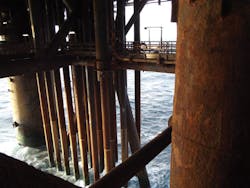Structural safety plan enhanced by more than three decades of data
Craig Moir
Fugro GEOS Ltd.
Operating company CNR International (CNRI) has been working with Fugro for more than three decades toward the development and maintenance of an asset integrity program on one of its Ninian oil platforms in the North Sea. These facilities are located about 386 km (240 mi) north-northeast of Aberdeen. For the past 35 years, CNRI has been working with Fugro to monitor the structural integrity of the Ninian South platform (NSP) for its structural integrity safety plan, using a permanent online monitoring (OLM) system.
This system was installed in 1985 following completion of initial structural integrity measurements in 1979, and is contracted through to 2020. It is an aging platform in an area of severe weather conditions, and the OLM system provides CNRI with the confidence that it is operating safely.
The concept for monitoring the natural frequencies of the platform remains virtually unchanged since installation. The system comprises four pairs of biaxial accelerometers, with one pair positioned on each of the four legs of the platform, combined with a wave radar to help correlate structural motions with wave conditions. The sensors allow Fugro to monitor the sway and torsion natural frequencies of the platform in response to changing weather patterns - any significant change in these values could indicate a loss in stiffness and would require further investigation.
What has changed dramatically is the communication system - the PCs, and the software (moving from UNIX through to Windows 7), and the speed and flexibility of reporting.
The data is collected on two robust platform-based PCs, as the OLM is designed with redundancy in mind. The stored information displays on the platform so the latest wave data - such as significant wave height, and the natural frequencies - can be clearly seen. Fugro provides the information in both tabular and graphical formats, so CNRI’s onboard team has a clear indication of a range of limits. If a value drops by a large amount, this is clearly indicated in red on the screen, providing an alert.
The data is processed onshore daily by Fugro on an automated basis, and a report is generated and received via email by the company’s onshore team, who checks key parameters and assess data trends.
Previously, the data was received from the platform through a satellite link to a base in Aberdeen. The Fugro team would then dial-in using an ISDN modem to download the data. Now, the fully automated system is internet-based: Daily reports reach specialists on their mobile phones, and they can log in to the platform from anywhere in the world and see the graphs as they appear in real-time on the platform itself.
This instant access enables Fugro to pick up anomalies. A high wave or significant change, such as a loss of stiffness of the platform, sees CNRI alerted; indeed, the CNRI team and their analysts determine the notification parameters. Equally, the onboard team can request a detailed check at any time, as the team is available 24/7 with a phone call support link.
The system proved its worth in 2006 when it picked up a brace failure. The problem was narrowed down to a subset of braces when a drop in natural frequency occurred; an inspection confirmed the suspicion. Once the repairs had been completed and the stiffness had been restored, the frequency rose, proving the value of constant monitoring.
Fugro Project Manager Waheed Siddiq, who leads the OLM activities on NSP, said: “After more than 35 years of monitoring NSP, our analysts know exactly how it behaves in all weathers; this intimate knowledge means we are able to identify any structural issues very quickly and accurately, and can alert CNRI immediately.”
Mark Wilson, Structural Technical Authority at CNRI said: “The support we get from Fugro is a vital part of our overall integrity management of this key asset. The information provided by the continuous monitoring of the structure helps us optimize our underwater inspection and provides an additional level of confidence in the condition of the platform.”




